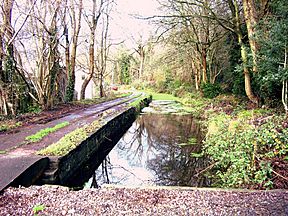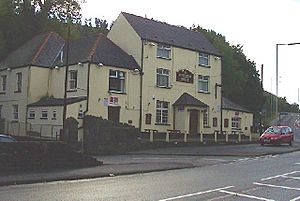Glamorganshire Canal facts for kids
The Glamorganshire Canal was a very important waterway in South Wales, UK. It started being built in 1790. This canal followed the River Taff valley, connecting Merthyr Tydfil to the sea at Cardiff. It helped transport goods for many years. The last part of the canal closed in 1951.
| Top - 0-9 A B C D E F G H I J K L M N O P Q R S T U V W X Y Z |
Building a Waterway: The Glamorganshire Canal
The Glamorganshire Canal project began in 1790. Rich iron factory owners in Merthyr Tydfil, like Richard Crawshay from Cyfarthfa Ironworks, needed a way to move their products. They wanted to transport heavy goods like iron ore, coal, and limestone. These materials came from the valleys and needed to reach Cardiff. From Cardiff, they could be shipped all over the world.
To solve this problem, they hired Thomas Dadford. His job was to check the land and plan the best route for the canal. With help from Lord Cardiff, the British Parliament officially approved the canal on June 9, 1790.
About £90,000 was collected to build the canal. This money would also help build smaller canals and railways. These smaller routes would connect factories within 4 miles (6.4 km) of the main canal.
However, the canal had a big problem near Cardiff. It often ran out of water. This meant goods could not reach Cardiff on time. To fix this, a water pump was built in Melingriffith in 1807. Its main job was to bring water from the River Taff to the canal. Historians are not sure who designed this pump. Some think it was Watkin George (1793) and others believe it was John Rennie (1795).
How the Canal Was Built
The company building the canal was called the Company of Proprietors of the Glamorganshire Canal Navigation. They were allowed to raise £60,000 to build the main canal. They could also raise an extra £30,000 if needed. This money also covered smaller branch canals and railways. These railways would link factories within 4 miles (6.4 km) of the canal. The company could even buy land for these railways if needed.
Construction started in August 1790. Thomas Dadford, a student of famous canal engineer James Brindley, arrived with his son, Thomas Dadford, Jr., and a team of workers. They began building from the Merthyr Tydfil end. A small extension was also built from Merthyr to Crawshay's Cyfarthfa Ironworks. There was a disagreement about payment for this part, but it was later settled.
A plan to build a branch to the Dowlais and Penydarren Ironworks was dropped. This branch would have gone up 411 feet (125 m) in just 1.75 miles (2.8 km). Instead, two tramroads (special railways) were built from each factory.
The section from Merthyr to Newbridge (now called Pontypridd) was finished by June 1792. More of the canal opened to Pwllywhyad (Treforest) in January 1793. By June 1793, it reached Taffs Well. By this time, the project was costing much more than planned.
The final section to Cardiff opened on February 10, 1794. But it was not built very well. There were many times when it had to close for repairs in 1794. The canal even broke open in December. Dadford refused to fix it without getting paid, even though his contract said he should. He fired his workers and left the job.
The canal company tried to get £17,000 back from the Dadfords. They even had them arrested. But two independent experts said the Dadfords were mostly right. Only £1,512 was returned.
The canal was about 25 miles (40 km) long. It dropped about 542 feet (165 m) from start to finish. This required 50 locks to help boats move up and down. The canal stayed on the western side of the valley until Navigation (now Abercynon). There, it crossed the River Taff on a special bridge called an aqueduct. Then it stayed on the eastern side for most of the way to Cardiff.
A second law was passed on April 26, 1796. This allowed the canal to be extended by half a mile (0.8 km). It would end with a sea lock in Cardiff docks. This part opened in June 1798. People celebrated with a boat parade and cannons firing. The total cost of the canal was £103,600. This included buying the land and paying the Dadfords.
Even though the Dadfords left under a cloud, their work was later proven good. They went on to build other canals. John Bird said in 1796 that the canal was "brought through mountainous scenery with wonderful ingenuity."
How the Canal Was Used
Richard Crawshay owned the most shares in the canal company. He seemed to use his power to benefit himself. He tried to make it harder for other iron factory owners to make money. This led them to suggest building a railway from Merthyr to Cardiff. This railway would compete with the canal.
Crawshay did not like this idea. So, the canal fees were lowered a bit. But the iron factory owners on the east side of the Taff Valley still built the Merthyr Tramroad. This railway opened in 1802. It connected their factories to the canal at Abercynon, near the River Taff aqueduct.
Water for the top of the canal came from the Cyfarthfa ironworks. This water used to flow back into the River Taff. This allowed the Plymouth ironworks to reuse it. To protect this water supply, water from the third lock was supposed to go to the Plymouth works. It was not supposed to go into the canal below. This caused arguments for many years. There were even lawsuits and sometimes damage to make sure water went to the Plymouth works. The problem got easier when the Merthyr Tramroad opened. Less traffic on the upper canal meant less water was used by the locks.
The canal made good money for many years. The law said that profits (dividends) could not be more than eight percent. So, between 1804 and 1828, extra profits were given back to traders. Sometimes, no fees were charged. Other times, fees were cut to a quarter of the normal price.
In 1841, railways started to take over the canal's business. The Taff Vale Railway opened to Merthyr. The canal managed to stay strong for another 20 years. But in the 1870s, iron factories started to close. Some also began making steel instead of iron.
In 1876, the canal company could not pay the full eight percent profit. After that, profits quickly dropped. The canal was sold to the Marquess of Bute in 1885. He made some improvements near Cardiff. But by 1886, six railway companies served Merthyr. They were all competing for business.
The upper parts of the canal, especially a 4-mile (6.4 km) section at Aberfan, were sinking. This was because of coal mining underground. An inspection was done. The canal from Merthyr to Abercynon was closed on December 6, 1898. This was done to keep the village of Aberfan safe.
The Canal's End
The Marquess of Bute bought the canal a bit too late to make a big difference. Improvements in Cardiff included building a new lock, Number 51. This raised the water level between there and Crockherbtown lock. This made the canal and the East and West Bute docks all the same level.
Traffic on the rest of the canal kept going down. In 1915, a break happened at Cilfynydd. The company decided not to spend money fixing it. Instead, they built a wooden channel around the break. This allowed water from the Elen Deg feeder to still reach the rest of the canal.
Another break happened on May 25, 1942, near Nantgarw. Engineers looked at the problem, but no work was done. Cardiff Corporation quickly agreed to buy the canal for £44,000. This plan became law in August 1943. They took control of the canal on January 1, 1944. They immediately said it was closed. Most business had already stopped in 1942.
However, a part of the law (Section 27) stopped them from closing the last mile above the sea lock. This was because sand traders were still using it. The city tried to make the sand traders leave. But the Ministry of War Transport said no. They said the sea lock area must stay open for boats until six months after the war emergency ended. The war emergency was not officially over until October 8, 1950.
Meanwhile, two sand and gravel companies kept using the sea lock. But the end came on December 5, 1951. A large steam dredger boat, called Catherine Ethel, crashed into the inner lock gates. The gates broke, and all the water in the 1-mile (1.6 km) section flowed into the estuary. The gates were never fixed. This solved the problem of closing the canal for Cardiff Corporation overnight.
The Glamorganshire Canal Today
Today, only small parts of the canal remain. About half of it is covered by the A470 road. This road connects Cardiff to Merthyr Tydfil and was built in the 1970s. Much of the Taff Trail, a walking and cycling path, follows where the canal used to be. This is between Abercynon and Merthyr Tydfil.
The section from Tongwynlais to the Melingriffith Tin Plate Works at Whitchurch still has water. It used to be used for fishing. Now, it is the Glamorganshire Canal local nature reserve. Also, a few bridges and locks are still standing. There are also short parts with water at Nightingales Bush and at Locks 31 and 32 in Pontypridd. There are plans to restore these areas.
A special machine that weighed boats was once at Tongwynlais. It was one of only four known in British canals. It was later moved to North Road, Cardiff. In 1955, it was given to the British Transport Commission. It was then set up again at the Stoke Bruerne Canal Museum in Northamptonshire in 1964. In 2013, it was moved to the National Waterfront Museum in Swansea.




